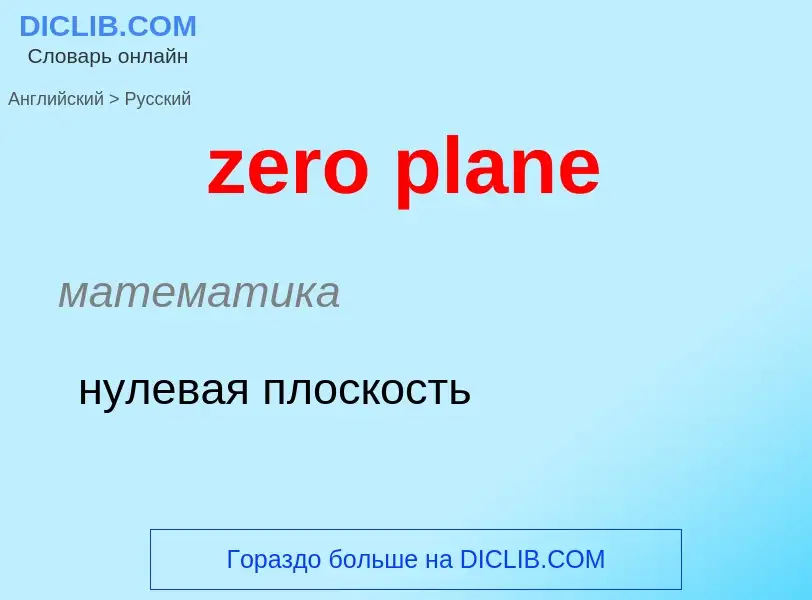Traducción y análisis de palabras por inteligencia artificial ChatGPT
En esta página puede obtener un análisis detallado de una palabra o frase, producido utilizando la mejor tecnología de inteligencia artificial hasta la fecha:
- cómo se usa la palabra
- frecuencia de uso
- se utiliza con más frecuencia en el habla oral o escrita
- opciones de traducción
- ejemplos de uso (varias frases con traducción)
- etimología
zero plane - traducción al ruso
математика
нулевая плоскость
общая лексика
плановые координаты
математика
бесконечная плоскость
Definición
Wikipedia

The Mitsubishi A6M "Zero" is a long-range carrier-based fighter aircraft formerly manufactured by Mitsubishi Aircraft Company, a part of Mitsubishi Heavy Industries, and was operated by the Imperial Japanese Navy from 1940 to 1945. The A6M was designated as the Mitsubishi Navy Type 0 carrier fighter (零式艦上戦闘機, rei-shiki-kanjō-sentōki), or the Mitsubishi A6M Rei-sen. The A6M was usually referred to by its pilots as the Reisen (零戦, zero fighter), "0" being the last digit of the imperial year 2600 (1940) when it entered service with the Imperial Navy. The official Allied reporting name was "Zeke", although the name "Zero" (from Type 0) was used colloquially as well.
The Zero is considered to have been the most capable carrier-based fighter in the world when it was introduced early in World War II, combining excellent maneuverability and very long range. The Imperial Japanese Navy Air Service (IJNAS) also frequently used it as a land-based fighter.
In early combat operations, the Zero gained a reputation as a dogfighter, achieving an outstanding kill ratio of 12 to 1, but by mid-1942 a combination of new tactics and the introduction of better equipment enabled Allied pilots to engage the Zero on generally equal terms. By 1943, the Zero was less effective against newer Allied fighters due to design limitations. It lacked hydraulic boosting for its ailerons and rudder, rendering it extremely difficult to maneuver at high speeds. By 1944, with Allied fighters approaching the A6M levels of maneuverability and consistently exceeding its firepower, armor, and speed, the A6M had largely become outdated as a fighter aircraft. However, as design delays and production difficulties hampered the introduction of newer Japanese aircraft models, the Zero continued to serve in a front-line role until the end of the war in the Pacific. During the final phases, it was also adapted for use in kamikaze operations. Japan produced more Zeros than any other model of combat aircraft during the war.


![[[2017 Red Bull Air Race of Chiba]] (N553TT) [[2017 Red Bull Air Race of Chiba]] (N553TT)](https://commons.wikimedia.org/wiki/Special:FilePath/2017RedBullAirRaceChibaMitsubishiA6MZero.jpg?width=200)

![The cockpit (starboard console) of an A6M2 which crashed into Building 52 at [[Fort Kamehameha]] during the attack on Pearl Harbor, killing the pilot. The cockpit (starboard console) of an A6M2 which crashed into Building 52 at [[Fort Kamehameha]] during the attack on Pearl Harbor, killing the pilot.](https://commons.wikimedia.org/wiki/Special:FilePath/A6M2 Cockpit.jpg?width=200)
![Carrier A6M2 and A6M3 Zeros from the aircraft carrier ''[[Zuikaku]]'' preparing for a mission at Rabaul Carrier A6M2 and A6M3 Zeros from the aircraft carrier ''[[Zuikaku]]'' preparing for a mission at Rabaul](https://commons.wikimedia.org/wiki/Special:FilePath/A6M2 Zuikaku Rabaul.jpg?width=200)
![A6M3 Model 22, flown by Japanese ace [[Hiroyoshi Nishizawa]] over the Solomon Islands, 1943 A6M3 Model 22, flown by Japanese ace [[Hiroyoshi Nishizawa]] over the Solomon Islands, 1943](https://commons.wikimedia.org/wiki/Special:FilePath/A6M3 Model22 UI105 Nishizawa.jpg?width=200)



![Atsugi Naval Air Base]]) and captured by US forces. Atsugi Naval Air Base]]) and captured by US forces.](https://commons.wikimedia.org/wiki/Special:FilePath/A6M5 scrapped.jpg?width=200)
![A6M2 "Zero" Model 21 of ''[[Shōkaku]]'' prior to attack on Pearl Harbor, 7 December 1941 A6M2 "Zero" Model 21 of ''[[Shōkaku]]'' prior to attack on Pearl Harbor, 7 December 1941](https://commons.wikimedia.org/wiki/Special:FilePath/Carrier shokaku.jpg?width=200)

![A6M on display at [[Dirgantara Mandala Museum]], Indonesia A6M on display at [[Dirgantara Mandala Museum]], Indonesia](https://commons.wikimedia.org/wiki/Special:FilePath/Mitsubishi-A6-M5-Zero-Zen.jpg?width=200)
![Wrecked A6M Zero in [[Peleliu]] jungle Wrecked A6M Zero in [[Peleliu]] jungle](https://commons.wikimedia.org/wiki/Special:FilePath/Mitsubishi-A6M-Zero-Peleliu-2016-Luka-Peternel.jpg?width=200)
![A6M5 on display at [[Yūshūkan]] in Tokyo, Japan A6M5 on display at [[Yūshūkan]] in Tokyo, Japan](https://commons.wikimedia.org/wiki/Special:FilePath/Mitsubishi-A6M-Zero-Yushukan-2016-Luka-Peternel.jpg?width=200)



![Pearl Harbor]]. Pearl Harbor]].](https://commons.wikimedia.org/wiki/Special:FilePath/Zero Akagi Dec1941.jpg?width=200)
